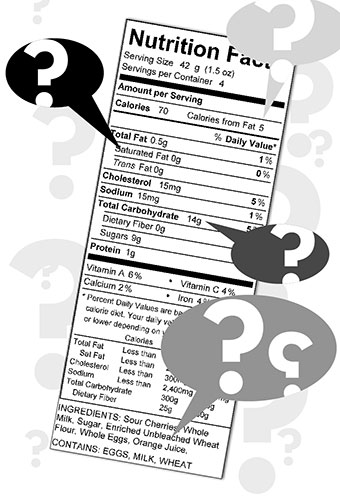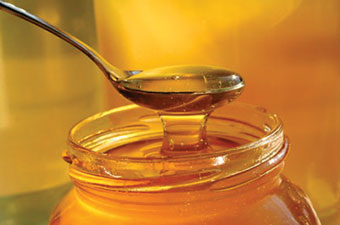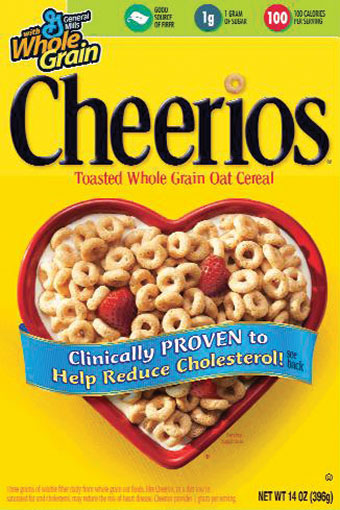Next story: The ABCD's of Western New York Healthcare
What's In That Can?
by Ann Marie Awad

Food labeling has become more about marketing than information
The relationship between consumers and their food is ever-changing and just as politically charged as the nightly news, but what makes it so complicated?
Food labeling, meant to be a way to make food clear and understandable, has become a confusing mess. Fad diets point dieters in all sorts of directions in terms of nutrient guidelines, almost everything from cereal to TV dinners makes health claims, and a great deal of typical food additives are far removed from what would be found in the average pantry. If anything, food labels have overcomplicated things.
As more people become conscious and outspoken about national food issues, food producers step up their game and slap on more labels meant to market products rather than to inform consumers. Here’s a guide to tying up some of the loose ends of labeling.
Greenwashing
By far the most popular trend in food labeling today is marketing “all natural” foods. In an effort to pick up on the heightened ecological concerns of today’s generation, more foods are wrapped in comforting brown and green, post-consumer packages with labels printed in soy-based ink. By trying to put the mind at ease by tapping into the consumer’s conscience, producers have made it easier to shill junk food.
While products that carry “all natural” labeling may be just that, don’t be fooled. The typical wearer of these labels is junk food. Items like cookies, chips, pop, and likewise greasy snacks are being rebranded as “natural” foods more and more everyday.
“For far too long, some of the world’s biggest food manufacturers have designed their labels either to exaggerate the amount of healthy ingredients, or to imply that the food has magical, drug-like qualities that could prevent or treat various health problems,” said Bruce Silverglade, legal affairs director for the Center for Science in the Public Interest (CSPI), in an interview with the New York Times in January.
Under current FDA laws, foods containing high fructose corn syrup (HFCS) can legally be labeled as “all natural,” as well as food containing additives like partially hydrogenated soybean oils. Items like these, being artificially synthesized, cannot be found in nature. Doesn’t sound so “all natural,” does it?
Another issue with this marketing is that it has a tendency to deceive the consumer into thinking that they’re more healthful or beneficial foods. Because of the FDA’s tricky regulatory obstacle course, many companies can get away with this type of labeling. Here are three items with this type of labeling. Do any of these sound healthy to you:
• Lay’s Natural Thick Cut Sea Salted Potato Chips
• Turkey Hill All Natural Ice Cream
• Minute Maid Premium All Natural Flavors Berry Punch
Now be careful! Take into consideration the amounts of sugar, salt, and fat these products may contain, and then ask yourself if “all natural” means healthy.
Remember also that “all natural” and “organic” mean very different things. There is more stringent regulation in place for foods carrying any sort of “organic” labeling. (To learn more about what constitutes “organic,” check out the USDA website: http://www.ams.usda.gov/AMSv1.0/nop.)
Additives and confusing ingredients
FDA regulations require any food product containing more than one ingredient and/or larger than a certain serving size to carry an ingredient label. But what good does that do if you can hardly pronounce what most of the ingredients are?
This is some of the trickiest territory in food-label land. Not just anyone can walk into their laboratory and chemically break down a Twinkie to see what it’s made of. With a basic knowledge of a few questionable food additives, it can be a little easier to navigate the supermarket. CSPI provides some pointers on types of food additives to avoid:
• Sodium nitrite, which is added to certain meats and fish to preserve color. High levels (high meaning roughly five grams) are toxic in humans and animals.
• Sugar substitutes (aspartame, saccharin, sugar alcohols such as sorbitol, etc.). There is a great deal of controversy around artificial sweeteners, but nutrition experts will tell you time and time again that unless you have a condition that prevents you from doing so, go for the real thing. As a side note, sorbitol, which is found in most chewing gums and popular diet foods, contains laxative properties—another reason you should just stick to plain old sugar in moderation.
• Artificial colorings. Certain ones are safer than others, but as a rule of thumb (and because of ever-changing research), avoid them all together. A lot of the foods we eat are painted in pretty colors, but many of these pretty colors have been shown to cause cancer in several animal tests.
For more information on what additives are considered safe and which are not, go to http://www.cspinet.org/reports/chemcuisine.htm. The FDA also has an online database of all the documented food additives called “Everything Added to Food in the United States” (EAFUS).
All of this can seem pretty scary, and it’s understandable. Michael Pollan, in his book Food Rules, has some advice that’s easy to remember: “Don’t eat anything with more than five ingredients or ingredients you can’t pronounce.”

High fructose corn syrup—it comes from corn, right?
Yes, it does. But that doesn’t necessarily mean it’s healthy. The recent ad campaign aimed at boosting the image of HFCS has caused all sorts of confusion for consumers.
For starters, the most nebulous claim: HFCS “has the same natural sweeteners as table sugar.” This is simply not true. Granulated sugar, or “table sugar,” is comprised of sucrose. HFCS is comprised of fructose and glucose. Not a big lie, right? That’s not the point. The problem here is deception.
The ads, paid for by the Corn Refiners Association, are using the same tactics as greenwashing marketing. By convincing the consumer that something is “natural,” it fools them into believing that it’s somehow healthy. In reality, HFCS is heavily refined and nothing like it occurs in nature.
The problem with HFCS is that almost all processed foods contain it. Ketchup, for example, has a much higher sugar content than most candies thanks to HFCS. HFCS is even added to many brands of children’s vitamins. While HFCS has been determined to be safe, the issue is that sugar needs to be consumed in moderation, but because it’s in practically everything, moderation is difficult.
Why is it everywhere? Corn is a subsidized crop in the US, so it’s incredibly cheap. HFCS is only one of the many food additives synthesized from corn. It also acts as a preservative, extending the shelf-life of food products. For food producers, it’s a boon.
Foods that shouldn’t contain sugar, generally savory foods, are the ones you should look out for. Keep an eye out for labels on kid foods; the presence of HFCS everywhere is one of the contributors to the childhood obesity epidemic.

Food that makes claims
The one thing food should not do is sell itself to you. Food should not be coolly persuading you to open your wallet, and it certainly shouldn’t be doing that by making snake oil claims.
In May 2009, the FDA issued a warning letter to General Mills in regards to the health claims made on boxes of Cheerios. The letter warned General Mills that they were broaching on pharmaceutical territory, and in doing so, they were misleading consumers: “Based on claims made on your product’s label, we have determined that your Cheerios® Toasted Whole Grain Oat Cereal is promoted for conditions that cause it to be a drug because the product is intended for use in the prevention, mitigation, and treatment of disease.”
Since then, similar food labeling has been policed more stringently, but some manage to slip through the cracks and loopholes is the FDA’s regulations. According to the CSPI, here are some you should watch out for.
• “Lightly sweetened.” The FDA has quantitative requirements in place for the terms “sugar free” and “no added sugar.” However, the terms “low sugar” and “lightly sweetened” can be used freely because they dodge the regulated language. Sugars are not considered a necessary dietary component, meaning there is no recommended dietary allowance (RDA) like there are with proteins and fats. So “low sugar” can mean just about anything.
• “A good source of fiber.” There are two types of fibers: naturally occurring and isolated. Naturally occurring fibers, as the name suggests, are present already in vegetables and whole wheat. Isolated fiber is processed from sources such as chicory root, and loaded into foods that wouldn’t otherwise include fiber—anything from yogurt to cereal and granola bars. Isolated fibers do not carry the same properties as naturally occurring fiber, in that they do not lower cholesterol or blood pressure. The only similarity is a laxative effect. The FDA does not require a distinction to be made on labels.
• “Made with real fruit.” This claim is particularly deceptive because it does not require the fruits advertised in the picture on the box to actually be present in the ingredients. Additionally, there are no requirements for how much, so it’s perfectly all right for there to be two percent fruit in your fruit juice.
• “Made with whole wheat.” Similarly, there is no requirement for how much whole wheat needs to be present in the ingredients to qualify for this label. Many products mix trace amounts of whole wheat flour into processed flour, and often contain more sugar than fiber as a result.
What’s left to eat?
Most, if not all, of these concerns apply to processed food. The simple solution is to go for whole foods, foods that occur in nature or foods that are made with ingredients that occur in nature.
HFCS isn’t simple. Sodium sulfate isn’t simple. Potatoes are simple. Carrots are simple.
Simplicity is simple.
blog comments powered by Disqus|
Issue Navigation> Issue Index > v9n37 (Health & Fitness Issue, week of September 16) > What's In That Can? This Week's Issue • Artvoice Daily • Artvoice TV • Events Calendar • Classifieds |









 Current Issue
Current Issue